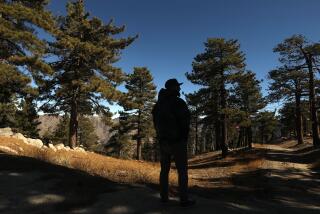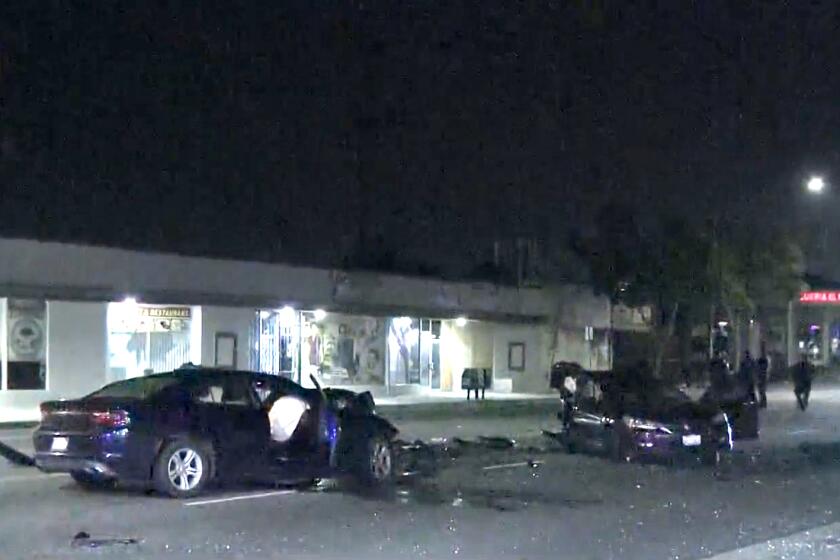South County Soar Spot : Unplanned Hot-Air Balloon Landings Worry Those Living Under Flight Path
- Share via
With a roar of a burner, the rainbow-colored balloon rose from a grassy park in Laguna Beach and floated over Aliso Canyon, sending a deer scampering through the thick underbrush. From their perch in a straw basket, the five passengers could see the blue-gray peaks of Saddleback Mountain to the east and the deepening blush of the setting sun on the ocean to the west.
The exhilaration and serenity of the flight ended abruptly when the balloon landed with a slight bump about 50 minutes later in a vacant lot close to a new housing tract in Laguna Niguel.
Gathered to greet the balloon was a large group of the curious--as well as a sheriff’s patrol car and a sheriff’s helicopter circling overhead. “This is not good for business,” said a balloon crew member when a deputy started asking questions.
As darkness fell, the balloon’s pilot waited 90 minutes for the arrival of a Federal Aviation Administration inspector with more questions.
The appearance of hot-air balloons in Orange County has prompted both interest and skepticism.
The colorful balloons plying the late-afternoon skies of South County have excited the imaginations of many local residents with their beauty.
Al Moorman, a retired Air Force pilot, drove to the Laguna Niguel balloon landing last week so his 3-year-old granddaughter could see it. “We were near the beach and came all the way up following it,” he said.
But initial reactions of joy and awe have been overshadowed in recent weeks by the concerns of some homeowners who fear that the balloons, which are up to nine stories high and depend on the vagaries of the wind to set their course, may pose a hazard.
The FAA is investigating Sunset Balloon Flights Inc., a commercial ballooning operation, in response to allegations that the balloons are flying low enough over populated areas to intrude on privacy, distract motorists and possibly crash into homes or utility lines.
And on Monday, the Orange County Sheriff’s Department referred to the district attorney cases involving the obstruction of a public road when a balloon landed on it and illegal entry through a blocked road by a chase vehicle attempting to retrieve a balloon.
Concern about the ability of balloon pilots to prudently choose their landing spots intensified over the Labor Day weekend when balloons made a rash of unscheduled landings--on a public street, inside a locked gated community and on a junior high school football field.
There have been other surprise landings.
A priest at St. Timothy Catholic Church in Laguna Niguel recently accommodated a pilot who shouted from the sky a request to land a balloon in the church parking lot.
Less tolerant security guards at Saddleback Community College in Mission Viejo yelled through bullhorns to try to prevent a pilot from landing a balloon on campus. When that failed, they called police.
At the center of this is Frank Reed, a 48-year-old balloonist with a license to take paying customers on excursions. After operating a similar business for more than three years in Del Mar, north San Diego County’s hub of ballooning activity, Reed was the first to launch a commercial enterprise last May in South Orange County.
Reed said balloon operators in the past hesitated to venture into Orange County in the belief that they would interfere with flights out of the El Toro Marine Air Corps Station. But he said he studied FAA maps and discovered that balloons could operate at altitudes up to 2,500 feet in Dana Point and 1,500 feet in Mission Viejo and Laguna Niguel.
“Orange County is an excellent area for ballooning,” he said. “There are real pretty views, mild winds and people with a lot of disposable income”--an important consideration since he regularly charges $165 for a balloon ride, with a current introductory charge of $145.
Ballooning has become very popular among tourists and Orange County residents looking for a lark or a fun way to celebrate birthdays and anniversaries.
On Friday afternoon, the balloon basket was draped with a sign that said “Happy Birthday,” in honor of two couples. “It is a surprise present,” said Kim Quirk of Costa Mesa, who wanted something special to mark the 22nd birthday of her boyfriend, Scott Boren.
“We often see it over our house about 6 p.m., and we thought it would be fun,” said Rick Nunez of Laguna Niguel, who treated his wife, Anita, to the ride for her birthday.
Capt. Doug Storm of the Sheriff’s Department said he has nothing against the sport of ballooning. “It would be a viable business if (Reed) does it right and addresses everybody’s concerns,” he said.
Storm has asked Reed to obtain written agreements with owners of property where he launches or lands his balloons.
It is Reed’s opinion--contested by Storm--that it is legal for his six pilots to land on any vacant parcel as long as it is not posted against trespassing, the owner does not object and nothing is damaged.
Nonetheless, Reed has begun negotiating with landowners and taking steps to obtain any required city permits and business licenses.
Reed admits that even after carefully studying and mapping South County’s terrain and wind currents, he never knows exactly where a balloon will land. “That is part of the romance and adventure of it,” he contends.
On Friday, the wind made the balloon drift short of a church where Reed has permission to land. So, he aimed for a nearby vacant lot with no clue about who owned it.
Some people who were inside homes that Reed cleared by 15 to 20 feet in making his landing said they were scared he might hit their roofs.
But Reed said he can accurately control the altitude of a balloon by using a propane-fired flame to heat the air inside the balloon when he wants to rise and lowering the flame when he wants to descend.
“It is an extremely safe sport,” Reed said. He said he always flies customers in the early morning or late afternoon when winds are lightest, at speeds of only 8 to 10 miles an hour. And he said he carries a $1-million insurance policy just in case an accident occurs.
Greg Livadas, spokesman for the Balloon Federation of America, said hot-air ballooning has a history of difficult relations with landowners, starting with the first manned balloon flights in the late 18th Century, “when they would land in farmers’ fields and the farmers would start attacking them with pitchforks.”
The early balloonists appeased the farmers, Livadas said, by bringing bottles of champagne to share with them, a tradition that modern balloonists like Reed still honor by ending each flight with a champagne picnic.
How a Hot-Air Balloon Works
There is no way to steer a hot-air balloon. Instead, the pilot maneuvers the balloon by heating or cooling the air inside it, causing it to move up or down into winds blowing in the right direction. Pilots try to stay near the liftoff area, floating back and forth at an altitude of 1,000 to 2,000 feet.
A. To lift off, pilot ignites burner that will fill balloon with hot air.
B. Balloon’s flight path is affected entirely by wind. To change direction, the pilot makes balloon rise or fall to find another wind current.
C. To land, pilot looks for wind current to carry balloon toward empty field. Pilot descends by slowly cutting off hot air to balloon.
Chase vehicle: Bus and truck follow balloon until it lands. Bus carries passengers, truck transports balloon back to liftoff area.
Basket
Propane burner, tank
Cooling vent
Source: Adventure Flights Inc.
Researched by APRIL JACKSON / Los Angeles Times
More to Read
Sign up for Essential California
The most important California stories and recommendations in your inbox every morning.
You may occasionally receive promotional content from the Los Angeles Times.










